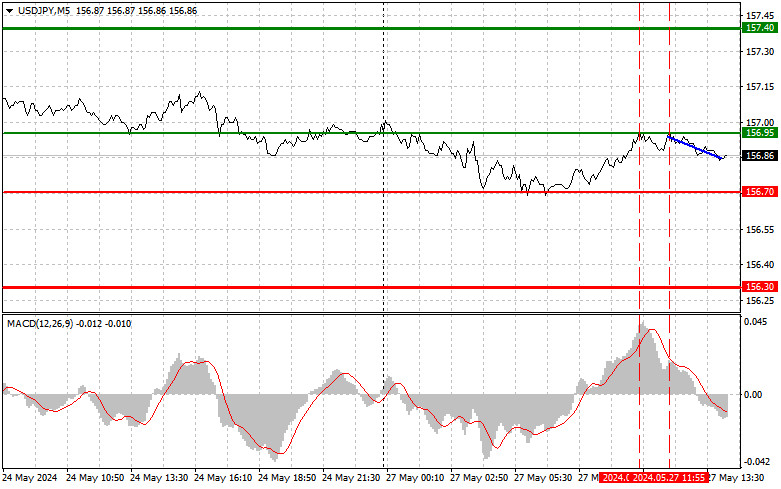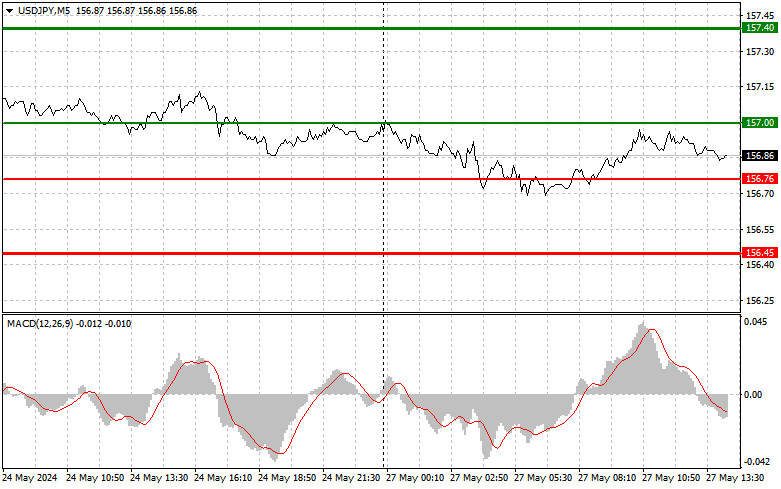
Analysis of transactions and tips on trading the Japanese yen
The first test of the price of 156.95 came when the MACD went up a lot from zero, which limited the further upward potential of the dollar. After a short period, another test of 156.95 occurred when the MACD indicator was already descending from the overbought area, which allowed scenario No. 2 to be realized for the dollar sale. But so far, there has not been a major drop in the pair, and it is unlikely to come because, in the afternoon, there are absolutely no statistics on the United States that buyers can use. The cheaper dollar retains its attractiveness, and traders need time to evaluate it. As for the intraday strategy, I plan to act based on implementing scenarios No. 1 and No. 2.

Buy signal
Scenario No. 1: I plan to buy USD/JPY today when I reach the entry point around 157.00 (green line on the chart) to grow to the level of 157.40 (thicker green line on the chart). In the area of 157.40, I will exit purchases and open sales in the opposite direction (counting on a movement of 30-35 points in the opposite direction from the level). You can count on the pair's growth today to continue the trend, but you need to keep the daily minimum. Important! Before buying, ensure the MACD indicator is above the zero mark and is just starting to grow from it.
Scenario No. 2: I also plan to buy USD/JPY today for two consecutive price tests of 156.76 when the MACD indicator will be in the oversold area. This will limit the pair's downward potential and lead to an upward market reversal. We can expect an increase to the opposite levels of 157.00 and 157.40.
Sell signal
Scenario No. 1: I plan to sell USD/JPY today after updating the level of 156.76 (the red line on the chart), leading to a rapid decline in the pair. The key target of sellers will be the level of 156.45, where I will exit sales and immediately open purchases in the opposite direction (counting on a movement of 20-25 points in the opposite direction from the level). The pressure on the pair will return in case of an unsuccessful consolidation in the area of the daily maximum. Important! Before selling, ensure that the MACD indicator is below the zero mark and is just beginning its decline.
Scenario No. 2: I also plan to sell USD/JPY today for two consecutive price tests of 157.00 at a time when the MACD indicator will be in the overbought area. This will limit the upward potential of the pair and lead to a downward reversal of the market. We can expect a decline to the opposite levels of 156.76 and 156.45.
What's on the chart:
Thin green line is the entry price at which you can buy a trading instrument.
Thick green line is the estimated price where you can place Take profit or fix profits yourself, since further growth is unlikely above this level.
The thin red line is the entry price at which a trading instrument can be sold.
Thick red line is the estimated price where you can place Take profit or fix profits yourself, since further decline is unlikely below this level.
MACD indicator. When entering the market, it is important to be guided by overbought and oversold zones.
Important. Novice forex traders need to make decisions about entering the market very carefully. Before releasing important fundamental reports, staying out of the market is best to avoid falling into sharp fluctuations in the exchange rate. If you decide to trade during the news release, always place stop orders to minimize losses. You must place stop orders to avoid losing the entire deposit quickly, especially if you do not use money management but trade in large volumes.
Remember that you need a clear trading plan for successful trading, following the example I presented above. Making spontaneous trading decisions based on the current market situation is an inherently losing strategy for an intraday trader.